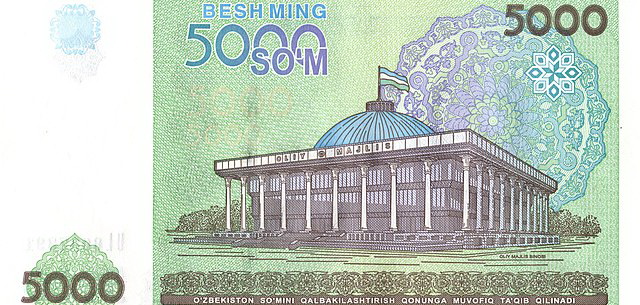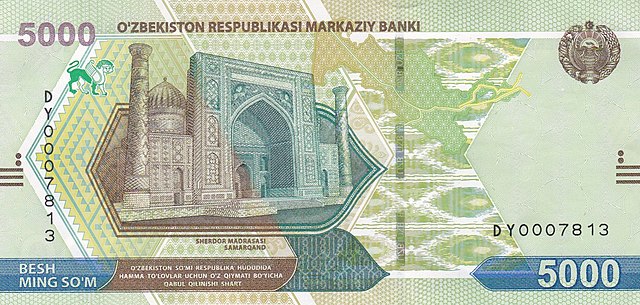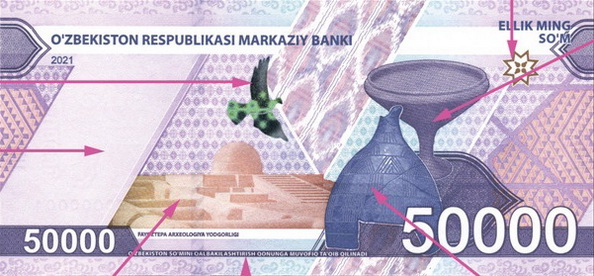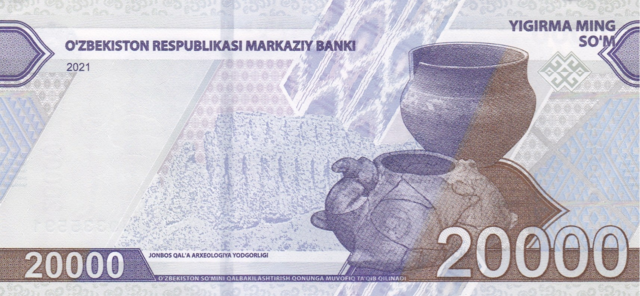State currency of Uzbekistan. What is it called and what does it look like?
The state currency of Uzbekistan is the sum, consisting of 100 tiyin. The word "sum" (so'm) means "pure" in Turkic languages. The 11th-century scholar Mahmud al-Kashgari mentions it about gold coins which makes it the most popular etymological version.
The national currency of Uzbekistan was established on July 1, 1994, and has the letter code UZS. In 1992-1993, it was preceded by the monetary unit sum-kupon, introduced in parallel with the Soviet ruble to protect the domestic market and fulfill social obligations. Their exchange rate was 1:1.
In 2004, the Uzbek sum became a convertible currency. Exchange offices are found at the airport, major hotels, and central markets, where euros and dollars are predominantly accepted. Other currencies are recommended to be exchanged directly at banks. The current exchange rate is available online, on the website of the Central Bank cbu.uz
The inscriptions on currency notes are made in the Uzbek language. Before 2013, the Cyrillic alphabet was used, and since 2013, the Latin alphabet is used.
Starting from 2021, coins of 50, 100, 200, and 500 sums and banknotes of 1000, 2000, 5000, 10,000, 20,000, 50,000, and 100,000 sums are in circulation. Watermark on banknotes from 1,000 to 50,000 sum is the Emblem of Uzbekistan, as well as figures of the nominal value. The banknotes of 5,000 and over are marked with contrasting shades. In general, all national currency notes of Uzbekistan differ from each other by colors, and images of historical and cultural monuments.
1,000 sum
The banknote is in lilac-brown shades, with the Emblem of Uzbekistan on the front side and the Timurid Museum on the back side. It was issued in 2001 and is still in circulation.


5,000 sum
The banknote of 2013 is in green shades, with the State Emblem on the front side and the building of the Parliament of Uzbekistan in Tashkent on the back side.
In 2021 a new design was issued in which brown color was added to green. The front side is decorated with Sher-Dor Madrasah in Samarkand, the back side displays the ancient settlement of Afrosiab and archeological artifacts found during excavations. Both versions are in circulation.




10,000 soum
The 2017 banknote is made in light blue colors, with the State Emblem on the front side and the building of the Senate of Uzbekistan in Tashkent on the back side.
In 2021 it was reissued with a changed design - the Kukeldash Madrasah in Tashkent is on the front side and the Shosh Tepa architectural monument is on the back side. Pink and purple shades were added to the original blue. Nevertheless, the old-style banknotes are still in circulation.




50,000 sum
The 2017 banknote is made in purple colors with the monument "Ezgulik Arkasi" on Mustakillik Square in Tashkent and the International Forums Palace is on the backside.
The redesigned banknote introduced in 2021 retains purple hues but complements them with blue and yellow tones. The Surkhadarya mausoleum of Al-Hakim at-Tirmizi decorates the front side, and the Buddhist complex Fayaz Tepa is on the backside.




100,000 sum. National banknote of the highest value
The light brown 2019 banknote is entirely dedicated to Mirzo Ulughbek, Tamerlane's grandson - the front side depicts a monument to Mirzo Ulughbek and the reverse side shows the observatory he built in Samarkand. It continues to be used in circulation.
The design of 2021 supplements the brown with shades of lemon and pink. The front side is replaced by the image of the inner city of Itchan-Kala in Khiva, while the reverse side features the architectural monument of Angka-Kala.




The banknotes of the new denomination issued in 2021 are united by the general idea of the Great Silk Road. The watermark is the contrasting figures of the denomination as well as a camel referring to the times of caravans.
The size is smaller, while the degree of protection is higher. A special lacquer coating protects them better from wear and tear. When developing the banknotes, the needs of visually impaired people were also taken into account, and the relief elements on the sides of the banknotes make it possible to determine their value.
2,000 sums
Pink and turquoise tones with the Ark Fortress of Bukhara are found on the front side and ruins of the ancient settlement of Paikent are on the backside.


20,000 soum
The banknote is in shades of blue, purple, and brown showing the architectural monument Koi Krylgan Kala in Karakalpakstan on the front side, and Dzhanbas Kala on the backside.


Despite the widespread use of bank cards and terminals, a significant part of the population still prefers to use cash to make purchases.









